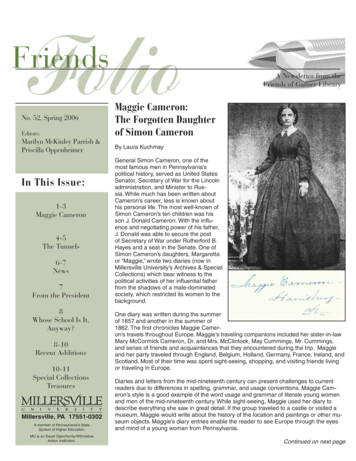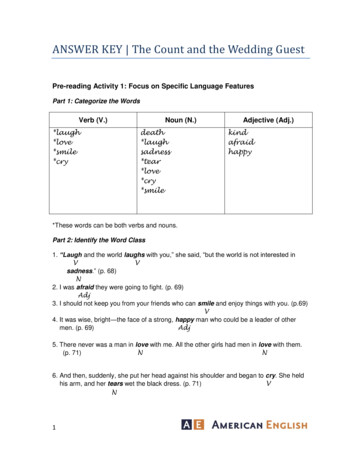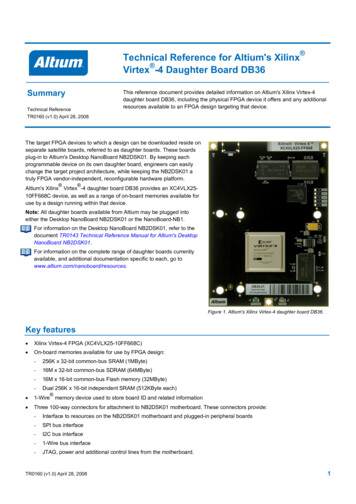
Transcription
FolioFriendsNo. 52, Spring 2006Editors:Marilyn McKinley Parrish &Priscilla OppenheimerIn This Issue:1-3Maggie Cameron4-5The Tunnels6-7News7From the President8Whose School Is It,Anyway?8-10Recent Additions10-11Special CollectionsTreasuresMillersville, PA 17551-0302A member of Pennsylvania’s StateSystem of Higher Education.MU is an Equal Opportunity/AffirmativeAction Institution.A Newsletter from theFriends of Ganser LibraryMaggie Cameron:The Forgotten Daughterof Simon CameronBy Laura KuchmayGeneral Simon Cameron, one of themost famous men in Pennsylvania’spolitical history, served as United StatesSenator, Secretary of War for the Lincolnadministration, and Minister to Russia. While much has been written aboutCameron’s career, less is known abouthis personal life. The most well-known ofSimon Cameron’s ten children was hisson J. Donald Cameron. With the influence and negotiating power of his father,J. Donald was able to secure the postof Secretary of War under Rutherford B.Hayes and a seat in the Senate. One ofSimon Cameron’s daughters, Margarettaor “Maggie,” wrote two diaries (now inMillersville University’s Archives & SpecialCollections) which bear witness to thepolitical activities of her influential fatherfrom the shadows of a male-dominatedsociety, which restricted its women to thebackground.One diary was written during the summerof 1857 and another in the summer of1862. The first chronicles Maggie Cameron’s travels throughout Europe. Maggie’s traveling companions included her sister-in-lawMary McCormick Cameron, Dr. and Mrs. McClintock, May Cummings, Mr. Cummings,and series of friends and acquaintances that they encountered during the trip. Maggieand her party traveled through England, Belgium, Holland, Germany, France, Ireland, andScotland. Most of their time was spent sight-seeing, shopping, and visiting friends livingor traveling in Europe.Diaries and letters from the mid-nineteenth century can present challenges to currentreaders due to differences in spelling, grammar, and usage conventions. Maggie Cameron’s style is a good example of the word usage and grammar of literate young womenand men of the mid-nineteenth century. While sight-seeing, Maggie used her diary todescribe everything she saw in great detail. If the group traveled to a castle or visited amuseum, Maggie would write about the history of the location and paintings or other museum objects. Maggie’s diary entries enable the reader to see Europe through the eyesand mind of a young woman from Pennsylvania.Continued on next page
FolioFriendsWhile in England, Maggie seemed to be quite fond of thecountryside, often observing similarities to America:Left Liverpool Tuesday morning at half-past 9 o' clockfor London. Passing over the London and Northwesternrailway and arrived there after passing over 210 miles.We passed through Warrick, Stafford, Rugby, Stanford,Banberry, Harrow on the Hill, Camden, and others, and athalf past four was at London. Some of the party wished togo in the second class cars and I, being the youngest ofthe party, had to submit. The cars are like our omnibusesthough with out cushions-but the seats run sideways andfive seats in each car-each holding 5 persons though butthree can sit comfortable. Every jolt or move of the caris felt, [in every] joint of the passenger. The country isa garden as it were from Liverpool to London and worthwhile to cross the ocean (though sick the whole way) tosee. (May 27, 1857)Maggie’s personality emerges through her diary entries.Because she was not under the constraints of her father andmother and their agendas, Maggie was able to relax andvisit the places she wanted to explore. In addition to in-depthdescriptions of cities, palaces, and museums, Maggie’scommentaries display her own well-mannered upbringingand wonderful sense of humor. Maggie has a brilliant way oftelling a story:Arrived at Amsterdam-six o’clock. Staid at the Hotel Daelins-had delightful rooms. In the evening a Mr. Montgomery Wilkins called to see Mr. Cummings, he not being withus. Dr. McClintock sent word that Miss Cummings was ofthe party. The young man made his appearance-with theair and graces of a dancing master. Could stay but a fewminutes, but stayed all evening. Spoke of his having somany Americans under his special care and how manyprincesses he had under his care at different times-andof his wearing the signal ring of the king, quite a man ofimportance. I think a fit subject for a mad house. (June 8,1857)By the end of the summer, Maggie and her traveling companions’ trip around Europe came to an end. In their last fewdays in England, a good amount of shopping was done andfinal letters home were sent. In her diary, Maggie announcesher desire to go home.2When Gen. Simon Cameron resigned as Secretary of Warin January, 1862, President Lincoln appointed him to fill thepost of Minister to Russia, which had been left vacant byCassius M. Clay. It was an important diplomatic mission to managethe relations between the UnitedStates and Russia’s Czar Alexander II. Gen. Simon Cameron lefton the ship the “Persia” in earlyMay of 1860, along with his wife,Mrs. Cameron, Maggie Cameron,Virginia “Jennie” Cameron, SimonCameron Jr., and a manservant,Mr. S.C. Burnside; Bayard Taylor,Secretary of the Legation, andfamily; and M. Louis Geoffrey,Secretary of the French Legation.The party sailed to England, then Courtesy of The PennsylvaniaFrance, and then traveled fromHistorical & MuseumCommissionParis to St. Petersburg by rail.Simon CameronMaggie chronicles the family’s experiences on the way toSt. Petersburg and also their first month or so in the Empire.While in London, Maggie, her family, and friends spent manyhours sight-seeing. Maggie details the places they visited,particularly the Tower of London:We started for home but on our way I spied the Tower andwe concluded to go there getting out of the carriage wewere met by one of the wardens. Their dress is the sameworn by them in Henry VIII time rather strange lookingnow. The honor of the appointment is bestowed on veterans who have distinguished themselves in their country’sservice. He bought our tickets for Armory and the regalia,six pence each. There are 12 towers. Bloody Tower, Bell,Beauchamp: Devereux, Flint, Bowyer, Birch, Jewel, Constable, Broad Arrow, Salt, Record Towers. Dark shadowsof the past enshroud the glooming fabric but they seem tothrow into stronger relief. The justice, and the liberty the intelligence and the refinement which illuminate our day. Wefirst came to the “Proctors gate.” How often have grandeurand lieu royalty passed through to exchange the dreamsof honor and of glory, the brilliancy of courts for therealities of the prison. The torture room, the gated black,Tape, there next through the gateway of the Bloody Tower,which admitted us into the wirer ward, glanced around atthe towers, those chill and lone lodgings, whose illustrious cassnes, have sighed out a lifetime. This tower is thetraditionary scene of the murder of the Royal children ofEdward 4 1483, two sons. The Brick Tower. Tradition assigns this as the prison of Lady Jane Gray. The Salt Tower,one of the most ancient buildings in the Fortress. He wentinto the Armory. This building 150 feet in length, and 34 inbreadth. Sheral military trophies and emblems adorn thewalls and ceiling the armor of the different reign’s helmet’stilting lances, spears, in the White Tower, Armor now inQueen Elizabeth times saw the heading block. Headingaxe, match look, all kinds of honorable things to destroywith saw the first of armor now by Henry 7th also the onenow by Henry 8th. (May 22, 1862)
Maggie describes visits to Madame Tussaud’s to see thewax figures, the Thames Tunnel, British Museum, NationalGallery, and Westminster Abbey. When the family traveledof their craft or occupation, and from seemed and thirdstones may be sear pictures of flutes, fiddles, tarts sugarplums, sausages, smoked ham, coats, bonnets, shoes,and stockings etc.Maggie’s journal ends with the family setting up their home inSt. Petersburg. As Minister to Russia, Gen. Simon Cameronhelped gain support from the Czar for the Union, influencingBritain and France not to aid the Confederate governmentduring the Civil War. In January, 1863, the Cameron family returned to America, so that Maggie’s father could seekelection to the Senate from Pennsylvania. His bid for officewas not successful. The family moved into a mansion onFront Street, in Harrisburg, which Maggie’s father changed toreflect fashions he witnessed while traveling in Europe.to Paris, Maggie found herself on a fast-paced tour of thecity, visiting the Tuileries Gardens, Place de la Concorde, theChamps Elysees, and the Zoological Gardens. The familydid a good amount of shopping while in Paris. It is believedthat the mirrors that now hang in the John Harris/SimonCameron House in Harrisburg were bought while the familytoured Paris. In Germany, the family was joined by Mr. Clay.Maggie writes about the city of St. Petersburg and mentionsthe differences she notices between the United States andthe countries of Eastern Europe. One thing in particularshe points out was the weather and culture of the differentclasses, especially when they arrived in Russia:Weather cold like our November weather, a great deal ofrain. Simon he arrived. Took a drive around the city, whyPeter should have selected this side for his city as strangers placed almost on the verge of the arctic regions andat the very extremely of the Russian dominions also soula marsh, its [?] to shall on to be made manageable forvessels. Larger sums said to the expended under groundthan alone every building constructed upon piles such isthe pedestal on which stands the citadel with all its walls,and seen the quays along the river side, the foot pavement and canals through the city, a necessity many of thedrawbridges are particularly striking from the cluster ofgranite columns, neither which is arranged the machineryfor raising and lowering the platform of the bridge thereare some suspension bridges. Which are very handsome,and have a pleasing effect from the multitude of gildedstars with which the now supporting rods, as hell as therailing of the bridge are covered, the sheet are paved withwood, carriages one and his horses flying and “shivai,shivai” is the constant cry “faster, faster”. The Russiansmade of advertising is not only novel, but amusing. Amongthe lower class the reading public is somewhat limited andmislead of placards they adverse by pictorial illustrationsOn May 12, 1870, Maggie Cameron married Richard J.Haldeman, son of Jacob and Eliza Haldeman. As an 1870graduate of Yale, Richard attended Heidelberg and BerlinUniversities and was an attaché of the U.S. Legation at Parisand later at St. Petersburg and Vienna. He later served asa congressman from the Harrisburg district for two terms,and was editor and publisher of the Harrisburg Daily Patriot.Richard was an interesting choice of husband for Maggie,as his views on slavery were completely opposite of herfather’s. Maggie and Richard had three children: Donald C.,Eliza, and Richard C. A dutiful wife and mother, Maggie wasalso very active in Harrisburg society as well as the YWTCU(Young Women’s Temperance Christian Union). When Gen.Simon Cameron died on June 26, 1889, of a stroke, he leftthe mansion on Front Street to Maggie. Maggie and her family lived there until she died on December 17, 1915.Maggie’s writings offer glimpses into the family life of one ofPennsylvania’s most famous politicians, as well as fascinating impressions of European and Russian cultural heritage.The diaries of Maggie Cameron are an attractive feature ofthe Millersville University Archives and Special Collections;they bring to light the story of a daughter who lived in theshadow of her famous father.Sources:Beck, Herbert H. "The Camerons of Donegal" Papers of theLancaster County Historical Society, 56 (4), 1952Diaries of Maggie Cameron, 1857, 1862Cameron Family Records, Dauphin County Historical SocietyLaura Kuchmay is a history major in her senior year atMillersville. She plans to pursue a double degree in history and library science/archival studies in graduate school.Laura is a student assistant in Archives & Special Collections, where she recently completed transcribing MaggieCameron’s diaries. An exhibit featuring Maggie Cameron ison display in the Archives and Special Collections ReadingRoom (fourth floor, Ganser library).3
FolioFriendsBuildings of Millersville“The Tunnels” is part of our regular series of articles highlighting the history of buildings and structures on Millersville’scampus.The TunnelsThe invitation printed in The Snapper read:By Kaelyn E. ConsidineHave you ever stopped to contemplate exactly what is buriedunderneath the ground you are walking on at Millersville?Well, if you are in the area of Ganser Library, Dutcher Hall, orBiemesderfer, chances are that you are standing on top of aseries of underground tunnels that snake their way throughthe older parts of the campus. The thousands of feet of underground walkways that were dug under the campus in theearly years of Millersville’s history are still in use today.Millersville Board of Trustee minutes indicate that a newsystem of steam heat was installed at the Normal School inthe 1890s. Sections of the tunnels in existence today wereoriginally built in order to transport the steam used to heatOld Main and other buildings on campus. Eventually theybecame a way for students to walk back and forth to theirclasses to avoid the bad weather. That was not their onlyfunction, however; anyone attending Millersville in 1935would tell you the highlight of their year was the legendaryHalloween party the faculty threw for the students. The “Tourof the Devil’s Kingdom” began in Old Main and ran the entirelength of the tunnel to a party at the end for the students.The whole of the passage was decorated as a hauntedhouse with the faculty dressed to play the roles of the terrifying scenes they were acting out for the students; one of themost notable being Miss Spencer (faculty member in English, 1923-1959) lying in a coffin at the end of the trail.4Other Halloween parties were held in the tunnels over thenext decade or so, but most of the students agreed that thesubsequent ones never quite measured up to the one in1935.
Today the tunnels are rarely used, unknown passages leftover from another time. Because most of them ran to andfrom Old Main, there is only one left that can take a travelerfrom one building to another; it runs from Dilworth to whereOld Main used to be but also connects to Biemesderfer, theold library. The tunnels themselves are simply undergroundhallways. The ones that the students used to go from classto class are just concrete walls with series of pipes and tubesrunning their entire length. They are not small cramped passages, rather they are about 7 ft. high and 5 ft. wide; morethan enough room for two people to walk comfortably sideby side. There are no skeletons, ghosts, or spirits of loststudents wandering the tunnels, rather one finds layers ofcobwebs with fossilized spiders still suspended in them. Thefloors are coated with dust and debris from the constant drilling of holes in the walls so that new pipelines and wires maybe run through them. Even upon entering it is clear that veryfew now visit these once frequented structures.Entrances to the tunnels can actually be found all over ifone knows where to look. The entrance to the tunnel thatruns from Dilworth to Old Main is easily visible upon entering Dilworth. When the old Science Building was renovated(located where Dilworth stands today), rather than closing offthe entrance to the tunnel they simply built around it closing itoff in a basement and locking the door above it. In the quadbetween Ganser Library and Dutcher Hall one need only tohave the right keys to open the various manhole covers inthe sidewalk in order to slip into Millersville’s fabled tunnels.With the destruction of Old Main, the tunnels of Millersvillebegan to fade from the knowledge of the students andfaculty. When Old Main was torn down and Ganser Librarybuilt, there was simply nowhere for the tunnels to go anymore. The place where they had entered Old Main was cutoff with brick walls and the tunnels became a series of longcorridors that conclude with dead ends. The tunnels now allow for the traverse of students in a different way; they carryphone lines and wiring for telecommunications. They arethe unseen, unknown couriers of information, still connectingstudents with the campus and with each other.Sources:“All Students Welcome,” The Snapper, October 25, 1935, p. 1.“Hades Hailed by Maskers,” The Snapper, November 8,1935, p. 3.Millersville Board of Trustees Minutes, 1891-1923Touchstone Yearbook, 1936.Mr. Kenneth Brent, University Architect, provided essentialbackground information and campus maps for this article.Kaelyn Considine is a senior at Millersville, majoring inhistory. She works as a student assistant in Archives andSpecial Collections.Stop by the Reading Room on the fourth floor of Ganserlibrary to view an exhibit featuring more information on thetunnels.It is the “maintenance tunnels” that look like what most wouldenvision. After climbing down a rusty old ladder one finds arectangular room with circular tunnels running from it. Constructed almost entirely of brick, this section is riddled withpipes and tubes, most of which were to serve Old Main andare no longer in use. These are tunnels with dripping ceilings, cracking walls, and floors that could best be describedas “spongy.” Traces of the 1960s and 70s are still there in theform of graffiti and asbestos.Planned Giving OpportunitiesConsider including Millersville University in your estateplanning. For more information on planned givingopportunities, including Ganser Library, Friends of theLibrary, or student scholarships, contact the MillersvilleUniversity Development Office at (717) 872-3820.5
FolioFriendsItemsNewsWe welcomed 375 students, staff, and facultymembers to Archives & Special Collections duringLibraryFest, held September 14, 2005. The primaryfocus of the celebration is to help all members ofthe university community become familiar with thelibrary and to have fun while learning basic locations and services. Those who visited all of thelocations won a library water bottle (approved foruse in the library) and were entered into drawingsfor additional prizes. This second annual LibraryFest celebration welcomed new and old friends todiscover the exciting resources available throughGanser Library.Wimer’s graduate class analyzed and discussed thevariety of historical primary source materials availablefor educational research.ENG 110 (English Composition): Dr. Carla Rineer’s twoclasses investigated primary source materials as thebasis for creative nonfiction essays. Students selected awide variety of topics from the admission of women andrules governing their behavior at the Normal School tothe experiences of Millersville students during the CivilWar to the approach used by authors of early texts in theareas of science and hygiene.HIST 105 (The Craft of History): Students in Dr. RonFrankum’s two classes researched a specific year inMillersville’s history, using The Snapper, Touchstone,college catalogs, and other Millersville archival recordsfor their research papers.HIST 279 (Public History): Professor Monica Spiese’sstudents learned about the world of archives throughhands-on projects. Each student processed an archivalcollection and created a summary of their approach.Newly processed records include athletics statistics,Hungarian Studies resources, and recipes from diningservices.LibraryFest visitors browse exhibit cases in the ReadingRoom.Classes Make Use of Archives &Special CollectionsFall semester was busy in Archives & Special Collections! From September through December, 2005, wehad over 1,030 student visits to our area. The followingclasses had instruction sessions, most requiring theuse of primary source materials for research and writingprojects:EDFN 376 (Whose School Is It, Anyway?): Students inDr. Cheryl Desmond’s class used archival materials tocreate the exhibit on display in the first floor referencearea of Ganser Library: Whose School is it Anyway?Students Research Millersville History in Archives &Special Collections.EDFN 601 (Research Methods): Students in Dr. Jeffrey6Book SaleMark your calendars for the 28th Annual Used BookSale sponsored by Friends of Ganser Library. The booksale will be held in Ganser Library lobby March 20March 22. The preview sale is Sunday, March 19, from6-7:30 p.m.Book Sale hoursMonday and Tuesday, March 20-21: 10 a.m. – 7 p.m.Wednesday, March 22: 10 a.m. – 6 p.m.The three-day sale offers a great selection of high qualityused books. We are always interested in receiving newvolumes for the sale, particularly juvenile, art, music, andcollectible books. Contact Leo Shelley (872-3610) if youwould like to donate books for the sale, or to arrange forbooks to be picked up.
Spring BanquetDr. Hank Fischer, Director of the MU Center of DisasterResearch and Education, is the featured speaker at theSpring Friends Banquet. Dr. Fischer will speak about thework of the center in responding to recent global disasters. The banquet will be held on April 11 in the BolgerConference Center, beginning at 6:00 p.m. Please joinus for this highly informative evening.From the PresidentDear Friends,The Friends of Ganser have been busy this academic yearwith a number of programs and initiatives. Ms. Barbara Johnson, past Vice President, coordinated a very well-attendedfall lecture featuring Dr. William Smith, MU philosophy professor discussing his love of movies and recent book FromPlato to Popcorn on September 13, 2005. Board memberMr. Phil Bishop, and his wife Sue, are to be congratulated inplanning and implementing the Friends’ sponsored bus trip tothe National Book Festival in Washington, D.C. on September 24, 2005. Two buses were filled with excited book lovers.The Friends are already planning for next year’s event.The Friends will be conducting the annual book sale held onMarch 19-22, 2006. Mark your calendars! The proceeds ofthe sale will be used to purchase items for the Special Collections area. Mr. Leo E. Shelley, Book Sale Chairperson, isthe contact person if you would like to make a contribution ofbooks for the sale. Mrs. Judy Carter, Vice President, is coordinating the spring banquet to be held at 6 p.m. on April 11 inthe Bolger Conference Center. The speaker will be Dr. HankFischer, MU Director for the Center of Disaster Researchand Education, presenting his findings on disasters and theireffects. With the 2005 major weather events like the Tsunamiin Asia, and Hurricanes Katrina, Rita and all the other hurricanes of 2005, and the major earth quake in Pakistan andKashmir, his presentation will be very timely.Dr. Hank FischerI invite you to join us at our upcoming events, the Book Saleand Spring Banquet.My thanks and warm regards to all the members for yourparticipation and support as true Friends of Ganser Library,Michelle M. White, PresidentFriends of Ganser LibraryBoard Members 2005-2006President—Michelle WhiteVice President—Judy CarterSecretary Treasurer—Catherine C. GlassPhilip R. BishopEx-Officio MembersAlexis FrancosGerald EckertJoseph GlassRobert ColeyBarbara HunsbergerDavid ZubatskyBarbara JohnsonLeo ShelleyJames JollyMarilyn ParrishRon LiebermanHolly Miller (Student Board Member)Priscilla OppenheimerDaniel WeinsteinMarjorie WhiteMartha WidmayerMarie ZubatskyBecoming a FriendPeople become Friends of Ganser Library when theymake a donation to Millersville University and requestmailings from the Friends. Encourage your friends tobecome Friends of the Library through their support ofMillersville University.For more information, contact the Millersville UniversityDevelopment Office at (717) 872-3820.7
FolioFriendsWhose School Is It, Anyway?Students Research MillersvilleHistory in Archives &Special CollectionsDuring Fall semester 2005, students completed an exhibitin Dr. Cheryl Desmond’s course, EDFN 376 Whose SchoolIs It, Anyway? The Struggle for Equity in American Schooling, an upper-level Perspectives course, cross-listed as aWomen’s Studies course. Students investigated the historical development of the public school in the United Statesto determine why and for whom public schools were created. As they studied questions regarding equity in publicschooling, they also sought to understand whose voices,both students and teachers, were/are heard. Whose voiceswere/are missing? And whose voices were/are silenced?AdditionsRecentEach issue of the Folio lists acquisitions made possiblethrough funding from the Friends of Ganser Library. Hereare highlights of some of the new materials we have recentlypurchased or received through donations.Several new additions highlight fascinating perspectivesrelating to health, moral issues, and family life in the 19thcentury in the United States.Health & HygieneDr. D. H. Jacques’ The Temperaments; or the Varieties ofPhysical Condition in Man, Considered in Their Relationsto Mental Character and the Practical Affairs of Life wasrepublished in 1888 (ten years after the first edition) following the death of the author. This small volume examines thetemperament in all its forms of expression. Physiologists andphrenologists of the late 19th century used a variety of approaches to understanding physical and emotional differences between human beings. Included in Jacques’ discussionare temperaments viewed pathologically, anatomically, bycolor, age, sex, races, and nations. Readers might be interested to learn that George Washington and Jenny Lind areconsidered fine examples of well-balanced temperament.Dr. Marilyn Parrish and Dr. Cheryl Desmond, with student Sarah Grimm,view exhibit cases.For the exhibit, students researched the history of MillersvilleUniversity as a “place where many public school teacherswere taught” by examining documents in Archives & SpecialCollections in Ganser Library. Each student selected anartifact that represented an aspect of the lives of faculty andstudents at Millersville, researched its significance, conducted a gender analysis of the artifact and contextualized itin university and national history. The exhibit begins in 1855and ends in 1980. It leads the observer through the lives ofpast students and faculty through the perspective of currentstudents.The exhibit is on display through the mid-Februaryon the first floor of Ganser Library. Janet Dotterer andstudent assistants in Archives & Special Collectionsassisted students with background research andscanning. Prof. Cheryl Lutz (Library) created theexhibit signs.8
Eating for Strength or Food and Diet in their Relation toHealth and Work together with Several Hundred Recipesfor Wholesome Foods and Drinks, by M.L. Holbrook, M.D.,was published in 1888. Holbrook, a professor of hygieneat the New York Medical College and Hospital for Women,examines the role of food and drink in nourishment of thebody, and includes a variety of recipes and warnings aboutspecific foods and their effects.Social Movements & Society ofFriendsWalks of Usefulness among the Sinning and the Sorrowing, or Reminiscences of the Life-Work of Margaret Prior,a biography of reformer Margaret Prior, was first publishedby Sarah Ingraham a year after Prior’s death in 1843. Priorwas actively involved in the New York Female Moral ReformSociety, which promoted sexual abstinence and temperance.The Society eventually became the American Female Reform Society, one of the first social movements in the UnitedStates organized by women.Dr. Charles West’s Lectures on the Diseases of Infancy andChildhood was alreadyin its fourth Americanedition (from the fifthrevised and enlargedEnglish edition) when itwas published by HenryC. Lea in Philadelphiain 1868. West drew thematerial for this volumefrom a series of lectures;he states:In 1848 these Lectureswere published as adistinct book; founded onthe notes of 600 casesand 180 post-mortemexaminations, which I hadobserved at the dwellingsof the poor in the districtwhere I labored Thepresent edition embodies the results of 1200records cases and of thenearly 400 post-mortemexaminations, collectedfrom between 30,000 and 40,000 children who, during thepast twenty-six years, have come under my care, either inpublic or in private practice.West’s lectures cover symptoms and treatment for healthconcerns such as convulsions, epilepsy, paralysis, night terrors, inflammation of the brain, diphtheria, whooping cough,pneumonia, jaundice, and small-pox.The second American edition of John Stuart Mill’s TheSubjection of Women, was published in yellow printed wrappers by D. Appleton and Company in 1870. This classic textoutlining the basic rights of women in society was publishedlate in Mill’s life (1806-1873). Mill begins with the following observation: "The principle which regulates the existingsocial relations between the two sexes—the legal subordination of one sex to the other—is wrong in itself, and now oneof the chief hindrances to human improvement it oughtto be replaced by a principle of perfect equality, admittingno power or privilege on the one side, nor disability on theother."The Rules of Discipline of the Yearly Meeting of Friends,for Pennsylvania, New Jersey, Delaware, and the EasternParts of Maryland: Revised and Adopted by the Said Meeting, Held in Philadelphia, by Adjournments from the 21st ofthe fourth month, to the 26th of the same, inclusive, 1834,was printed by Joseph Rakestraw in Philadelphia. It containsdecisions of the Yearly Meeting including appeals, arbitrations, discipline, views on slavery, education, taverns, war,and wills.9
FolioFriendsFamily & Home LifeMassachusetts in 1899. Sargeant discusses all aspects ofhome life, including music, education, amusements, homehygiene a
ing impressions of European and Russian cultural heritage. The diaries of Maggie Cameron are an attractive feature of the Millersville University Archives and Special Collections; they bring to light the story of a daughter who lived in the shadow of her famous father. Sources: Beck, Herbert H. "The Camerons of Donegal" Papers of the










